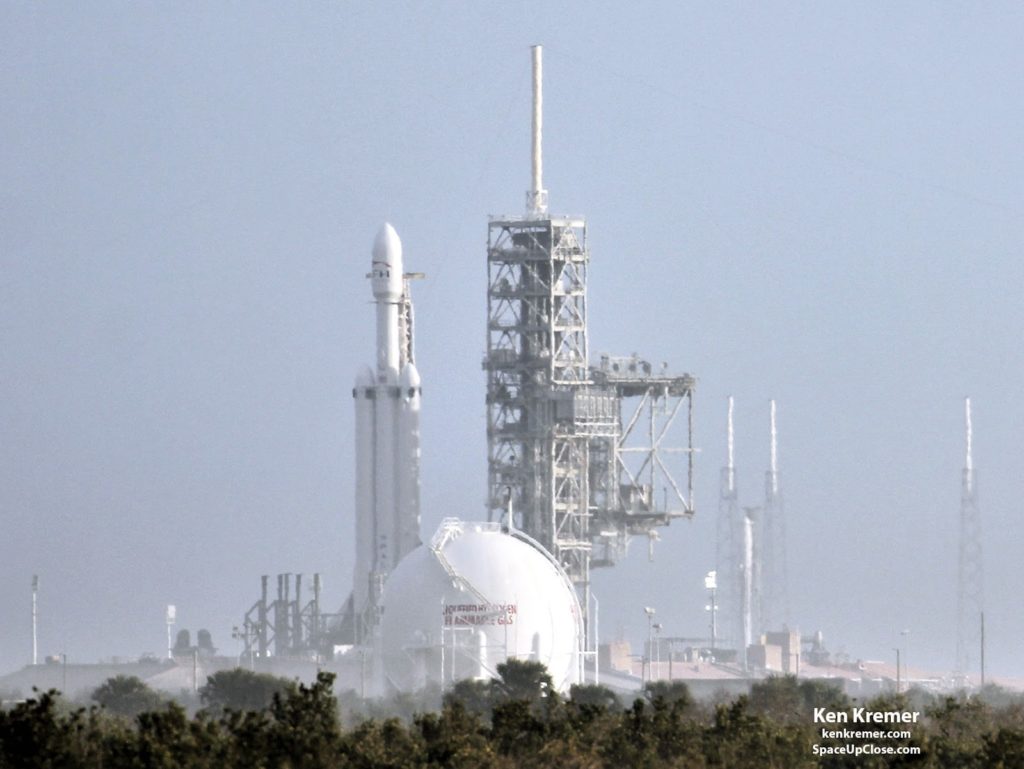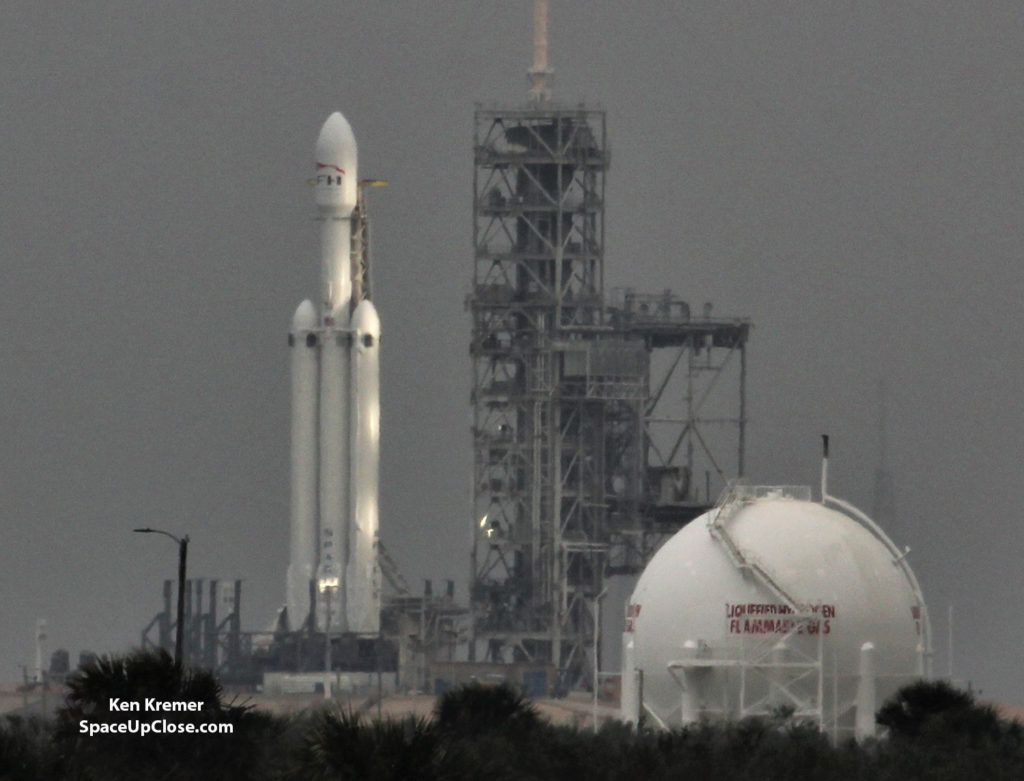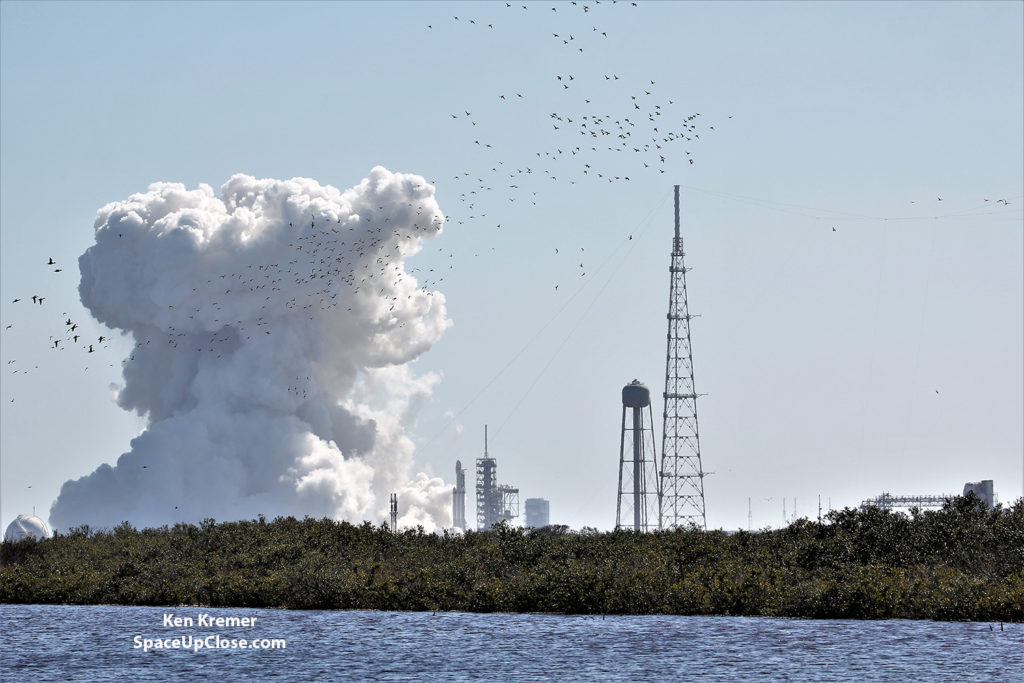Kremer — SpaceUpClose.com — 27
Jan 2018
the powerful triple stick SpaceX
Falcon Heavy rocket is now scheduled for blastoff on Feb. 6 from NASA’s Kennedy
Space Center announced SpaceX CEO and billionaire founder Elon Musk in a brief
tweet officially revealing the targeted launch date publicly for the first time
today.
first flight of Falcon Heavy on Feb 6 from Apollo launchpad 39A at Cape Kennedy,”
Musk tweeted Saturday, Jan. 27 – even as his firm’s single stick Falcon 9 targets
blastoff on Tuesday, Jan 30 on nearby pad 40 on the Florida Space Coast.
briefly a dynamic duo of SpaceX Falcon series of rockets simultaneously vertical
– as I witnessed and reported here. See
our exclusive Space UpClose gallery.
The triple core
rocket will lift off from historic pad 39A at the Kennedy Space Center in the early
afternoon during a launch window that opens at 1:30 p.m. EST on Feb. 6.
long launch window extends from 1:30 p.m. until 4:30 pm EST (18:30-21:30 GMT). The backup launch day is Feb. 7.
story tall Falcon Heavy vehicle will generate by far the loudest, most impressive
and tremendous sounds thundering out from Florida’s Spaceport since the shuttle
shutdown in 2011.
double dose of SpaceX Falcons totaling four cores launching back to back.
of the soon to be ‘World’s Most Powerful Rocket’ on its first demonstration
mission is at last at hand in less than 10 days time after years of
postponements to refine and validate the design and develop, ready and test this
incredible complex “beast” of a vehicle.
27
first stage Merlin 1D engines will ignite to generate nearly 5 million pounds
of liftoff thrust rumbling across the Florida Space Coast as it starts its history
making soar to space.
Falcon Heavy has about double the liftoff thrust of its nearest competitor – namely
the United Launch Alliance Delta IV Heavy.
says SpaceX President Gwynne Shotwell.
the Falcon Heavy can blast off, the Falcon 9 carrying the SES-16/GovSat-1 communications
satellite must safely deliver the commercial payload to geosynchronous transfer
orbit.
maiden Falcon Heavy’s payload is Musk’s Tesla Roaster that will be hurled
outward on a whimsical trip on a long looping heliocentric journey out to Mars
orbit but actually will approach nowhere near the Red Planet. Musk also owns Tesla.
Apollo Saturn manned Moon landing rockets as well the Space Shuttles lifted off
from Launch Complex 39A dating back to the 1960s for Apollo and the commencing
with the Shuttles in the 1980s until the retirement in 2011.
has leased pad 39A from NASA under a long term contract. After upgrading and refurbishing the
structures and facilities SpaceX reactivated pad 39A and began launching the
Falcon 9 in February 2017.
The fast approaching
Falcon Heavy launch has generated tremendous interest in the general public – in
addition to the space community – and local hotels and viewing locations are
expected to be swamped.
Space Center Visitor Complex has already sold out all ticket packages for the
two closest and most expensive viewing locations.
there are plenty of free viewing locations at beaches, highways, causeways and
parks ringing the Kennedy Space Center.
from the public causeway,” Musk noted.
launch team successfully completed the critical hold down static hot fire test just
days ago on Jan. 24, when all 27 Merlin engines were lit together for the very
first time.
here.
this video of the the Jan 24 static test fire:
Caption: SpaceX Falcon Heavy TEST FIRE Jan 24, 2018. America’s new rocket, the
inaugural SpaceX Falcon Heavy, came to life for the first time for a Static
Test Fire on KSC pad 39A Jan 24, 2018.
Credit: Jeff Seibert
successful static fire test is one of the last major milestones required before
SpaceX can attempt to really launch the Falcon Heavy on the maiden
demonstration mission of this very complicated vehicle.
payload is Musk’s Tesla Roaster that will be hurled outward on a whimsical trip
to Mars orbit.
triple stick Falcon Heavy is comprised of a trio of Falcon 9 boosters –
including a significantly modified central core, to deal with aerodynamic
stresses, that is attached to a pair of side-mounted cores with newly developed
nose cones mounted in place of payload fairings.
two side cores are ‘flight-proven’ boosters that already launched once and are
being recycled for the Heavy.
gigantic two stage Falcon Heavy stands more than 229 feet (70 meters) tall and measures 39.9 feet
wide (12.2 meters). It also features a
dozen grid fins and a dozen landing legs attached to the first stage boosters
in an attempt to soft land all three cores – by land and by sea.
for Ken’s continuing onsite coverage of Falcon Heavy, ULA and NASA and space mission reports direct
from the Kennedy Space Center and Cape Canaveral Air Force Station, Florida.
Earth and Planetary science and human spaceflight news: www.kenkremer.com –www.spaceupclose.com –
twitter @ken_kremer – ken
at kenkremer.com
and Falcon 9 SES-16/GovSat-1 launches on Jan. 30 & Feb. 6, NASA missions, ULA
Atlas & Delta launches, SpySats and more at Ken’s upcoming outreach events
at Kennedy Space Center Quality Inn, Titusville, FL:
launches, ULA Atlas USAF SBIRS GEO 4 missile warning
satellite, SpaceX SES-16/GovSat-1, CRS-13/14 resupply launches to the ISS,
Intelsat 35e, BulgariaSat 1 and NRO Spysat, SLS, Orion, Commercial crew
capsules from Boeing and SpaceX , GOES-S weather satellite launch, OSIRIS-Rex,
Juno at Jupiter, InSight Mars lander, SpaceX and Orbital ATK cargo missions to
the ISS, ULA Delta 4 Heavy spy satellite, Curiosity and Opportunity explore
Mars, NH at Pluto and more,” Kennedy Space Center Quality Inn, Titusville, FL,
evenings. Photos for sale






